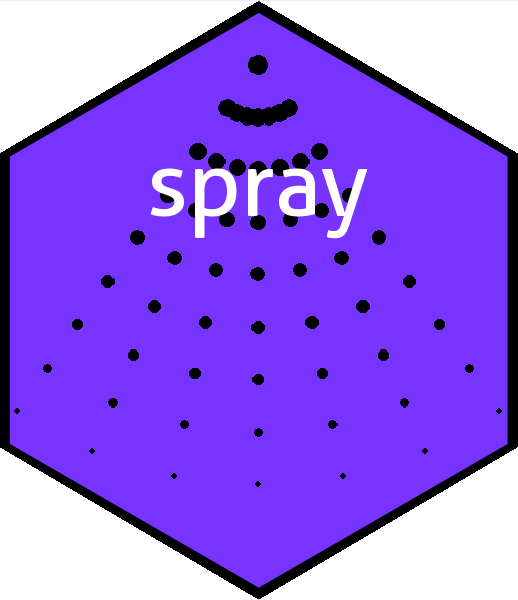

The spray package provides functionality for sparse arrays.
In a sparse arrays, nonzero elements are stored along with an index vector describing their coordinates. The spray package provides functionality for sparse arrays and interprets them as multivariate polynomials.
You can install the released version of spray from CRAN with:
spray package in useBase R has extensive support for multidimensional arrays. Consider
Handling a requires storage of floating point numbers (of which two are nonzero), represented in an elegant format amenable to extraction and replacement. Arrays such as this in which many of the elements are zero are common and in this case storing only the nonzero elements and their positions would be a more compact and efficient representation. To create a sparse array object in the spray package, one specifies a matrix of indices with each row corresponding to the position of a nonzero element, and a numeric vector of values:
library("spray")
M <- rbind(
c(2,2,2,2,2,2,2,2,2),
c(3,4,2,2,7,2,3,2,3))
S1 <- spray(M,7:8)
S1
#> val
#> 2 2 2 2 2 2 2 2 2 = 7
#> 3 4 2 2 7 2 3 2 3 = 8Note that object S1 is rather compact by comparison with plain array a, as it needs to record only a 18-element index array of integers and two double-precision entries. The order in which the elements are stored is implementation-specific (see the vignette for details and an extended discussion).
Basic arithmetic is implemented where appropriate. If we define
S2 <-spray(rbind(
c(1,2,3,1,3,3,1,4,1),
c(3,4,2,2,7,2,3,2,3)), c(100,-8))
S2
#> val
#> 1 2 3 1 3 3 1 4 1 = 100
#> 3 4 2 2 7 2 3 2 3 = -8then
(the entry with value 8 has cancelled out).
One natural application for spray objects is multivariate polynomials. Defining
S1 <- spray(matrix(c(0,0,0,1,0,0,1,1,1,2,0,3),ncol=3),1:4)
S2 <- spray(matrix(c(6,-7,8,0,0,2,1,1,3),byrow=TRUE,ncol=3),c(17,11,-4))
S1
#> val
#> 0 0 1 = 1
#> 0 1 0 = 3
#> 0 0 2 = 2
#> 1 1 3 = 4
S2
#> val
#> 6 -7 8 = 17
#> 0 0 2 = 11
#> 1 1 3 = -4it is natural to interpret the rows of the index matrix as powers of different variables of a multivariate polynomial, and the values as being the coefficients. This is realised in the package using the polyform print option, which if set to TRUE, modifies the print method:
(only the print method has changed; the objects themselves are unaltered). The print method interprets, by default, the three columns as variables although this behaviour is user-definable. With this interpretation, multiplication and addition have natural definitions as multivariate polynomial multiplication and addition:
S1+S2
#> +z +3*y +13*z^2 +17*x^6*y^-7*z^8
S1*S2
#> -16*x^2*y^2*z^6 -12*x*y^2*z^3 +17*x^6*y^-7*z^9 +68*x^7*y^-6*z^11
#> +34*x^6*y^-7*z^10 +22*z^4 +36*x*y*z^5 +33*y*z^2 +51*x^6*y^-6*z^8
#> -4*x*y*z^4 +11*z^3
S1^2+4*S2
#> +4*z^3 -16*x*y*z^3 +45*z^2 +6*y*z +12*y*z^2 +24*x*y^2*z^3 +9*y^2
#> +16*x^2*y^2*z^6 +4*z^4 +8*x*y*z^4 +16*x*y*z^5 +68*x^6*y^-7*z^8It is possible to introduce an element of symbolic calculation, exhibiting familiar algebraic identities. Consider the lone() function, which creates a sparse array whose multivariate polynomial interpretation is a single variable:
x <- lone(1, 3)
y <- lone(2, 3)
z <- lone(3, 3)
(x + y) * (y + z) * (x + z) - (x + y + z) * (x*y + x*z + y*z)
#> -x*y*zthus illustrating the identity .
Spray objects can be coerced to functions:
Differentiation is also straightforward. Suppose we wish to calculate the multivariate polynomial corresponding to
[ \frac{\partial^6}{\partial x\,\partial2y\,\partial3z} \left(xyz + x+2y+3z\right)^3.](https://latex.codecogs.com/png.latex?%0A%5Cfrac%7B%5Cpartial%5E6%7D%7B%5Cpartial%20x%5C%2C%5Cpartial%5E2y%5C%2C%5Cpartial%5E3z%7D%0A%5Cleft%28xyz%20%2B%20x%2B2y%2B3z%5Cright%29%5E3.%0A " (xyz + x+2y+3z)^3. ")
This would be
The package vignette offers a detailed discussion of the package design philosophy; also, the mvp package provides a further interpretation of the concept of “sparse” in the context of multivariate polynomials.